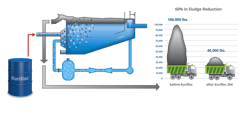Trojan Technologies Announces Acquisition of OpenCEL
The Trojan Technologies group of businesses has acquired the business assets of OpenCEL of Glencoe, IL. OpenCEL is an environmental biotechnology company that offers a proprietary technology which significantly improves processing of wastewater biosolids.
Used for pretreating wastewater sludge prior to anaerobic digestion, the technology employs high frequency electrical pulses to break open biomass cell membranes, releasing soluble material that is more readily digested and converted to energy, reducing the amount of biosolids that are produced and disposed.
The OpenCEL business will operate as a division of US Peroxide, a Trojan Technologies business headquartered in Atlanta, GA.
“This is a high-technology business that will continue to support US Peroxide’s goal of helping to optimize customer operations,” says Tom Walkosak, general manager, US Peroxide. “The OpenCEL technology reduces the cost of handling biosolids, while also increasing methane production that can be used beneficially within the plant or to generate electricity on site – this makes facilities more self-sustainable.”
NSF Publishes Standard for Water Reuse Systems
NSF International has published the first American national standard for commercial and residential onsite water reuse treatment systems, NSF/ANSI 350. The new standard complements the group’s expanding scope of environmental standards and sustainable product standards.
NSF/ANSI 350: Onsite Residential and Commercial Reuse Treatment Systems establishes criteria to improve awareness and acceptance of water reuse technologies. According to the American Water Works Association, 84 percent of residential water is used in non-drinking (non-potable) water applications such as lawn irrigation, laundry and toilet flushing. Residential and commercial builders, architects and regulators are turning to onsite wastewater reuse systems as a solution to increasing water scarcity and energy costs associated with the treatment and distribution of municipal water and wastewater.
Certifying a water reuse system to NSF/ANSI 350 also satisfies requirements for leading green building programs. The U.S. Green Building Council has included reference to NSF/ANSI 350 in their LEED (Leadership in Energy and Environmental Design) Building Design & Construction 2012 Draft Standard. Products certified to NSF/ANSI 350 also could satisfy graywater use strategies under the National Association of Home Builders (NAHB) National Green Building Certification program as an innovative practice.
NSF developed this American national standard for evaluating onsite water reuse technologies to ensure the systems properly treat graywater (i.e. wastewater generated from activities such as laundry and bathing) and combined wastewater (i.e. all sources of wastewater generated within a residence or building) for reuse in non-potable applications.
The standard establishes materials, design and construction, and performance requirements for onsite residential and commercial water reuse treatment systems and sets water quality requirements for the reduction of chemical and microbiological contaminants for non-potable water use. Treated wastewater can be used for restricted indoor water use, such as toilet and urinal flushing, and outdoor unrestricted water use, such as lawn irrigation.
Shawnee, Kansas-based Bio-Microbics, Inc., a manufacturer of clean technologies, is the first company to earn NSF/ANSI 350 certification for their Bio-Barrier® membrane bioreactor (MBR). NSF scientists conducted an evaluation spanning more than six months of continuous operation of the Bio-Microbics Bio-Barrier® MBR treatment system at one of NSF’s approved wastewater testing facilities.
“Certification to NSF/ANSI 350 positions onsite water reuse technologies as a viable solution to increasingly overburdened water and wastewater treatment facilities, water scarcity, and increasing costs associated with energy and water use,” said Tom Bruursema, General Manager of NSF Sustainability. “Innovative clean technology manufacturers, such as Bio-Microbics, can now demonstrate the acceptability and effectiveness of their products, helping these technologies to be adopted more quickly into the marketplace.”
Visit NSF’s website, www.nsf.org, to learn more about the NSF/ANSI 350 testing and certification program.
DuPont Fined for Water Quality Violations
The Delaware Department of Natural Resources and Environmental Control, the US Environmental Protection Agency, and state and federal Departments of Justice have entered into a consent decree with the DuPont Corp. in which the company has agreed to pay a penalty of $500,000 for numerous violations of the DuPont Edge Moor plant site’s National Pollutant Discharge Elimination System (NPDES) permit and other state and federal regulations.
Many of the violations at the facility – which makes a white pigment from titanium used in the print and publishing industries – were pollutant discharges into the Delaware River that occurred between 2005 and 2011. All of the violations, including state and federal Clean Water Act noncompliance, are covered in the consent decree signed with DNREC and EPA. DNREC first issued a notice of violation to DuPont in April 2008 for numerous effluent discharges that exceeded permit limits and for violations of other general NPDES permit conditions that were not met.
In addition to the penalty levied through the consent decree, DuPont has agreed to undertake an environmental compliance assessment, to be completed within 15 months, and develop a plan that must include a schedule for implementing and completing each corrective action to reduce the risk of future wastewater violations at the facility. EPA, in consult with DNREC, will then determine if the plan is to be approved.
Beyond this assessment, DuPont must also demonstrate that it’s implementing the facility’s stormwater pollution prevention plan (SWPPP) by submitting stormwater inspection reports to EPA for the duration of the consent decree.
Some of the more serious violations by DuPont were the discharges of hydrogen chloride, titanium tetrachloride and iron chloride into the Delaware River. Other violations include the discharges of ores, and overflow from the Edge Moor facility’s wastewater treatment plant’s neutralizers and clarifiers into the Delaware River.
Membrane System Targets Ethanol Byproduct
New Logic Research, based in Emeryville, Calif., has commissioned a full-scale membrane separation system at a Brazilian ethanol plant. The nanofiltration system was installed to concentrate an ethanol byproduct called vinasse (vinaza) and produce water for beneficial reuse.
While vinasse has traditionally been applied directly to the fields as a fertilizer, recent evidence suggests this practice is reducing sugar crop yields and shortening the useful life of the land. Adding to the current vinasse challenge is a two-year drought that has further strained the Brazilian sugar crop.
The i84 VSEP nanofiltration system currently recovers 70% of the raw vinasse as clean water for irrigation, leaving a concentrated vinasse that’s just 30% of its starting volume. This high nutrient value vinasse stream is currently sent to storage ponds while the ethanol producer weighs a multitude of options for beneficial reuse.
“With a vinasse to ethanol ratio of 16:1, the need for innovative treatment methods is clear. The success of this full-scale system validates the data collected at both the lab and pilot phases of the technology evaluation, and promises a very bright future for VSEP in Brazil,” said New Logic CEO Greg Johnson.
For more information about VSEP in ethanol applications, download a free whitepaper at http://www.vsep.com/ethanol.
Flow Control Helps Discourage Water Fowl
Thirsty Duck Ltd. has completed installation of an ER-200 Buoyant Flow Control Device (BFD) in the southwest detention pond at the Bellingham International Airport in Bellingham, WA.
The BFD is designed to deliver a constant discharge rate of 19 cfs. It was installed as part of an FAA grant funded project to convert the airport’s 6 acre wet detention pond to dry detention for the purposes of discouraging water fowl from inhabiting the site which is adjacent to the airport’s main runway.
The installation was completed Nov. 1, 2011 in less than 1 hour with a 4-person crew. The project was designed by Reid Middleton Engineers, Planners, Surveyors of Everett, WA.
Mobile Clarifier Tackles Flowback
Fountain Quail Water Management, a wholly owned subsidiary of Calgary-based Aqua-Pure Ventures, has deployed its ROVER mobile clarifier package. The system is designed for primary treatment of shale gas flowback at or near the source. The self-contained system, which can treat up to 10,000 barrels of flowback and produced water per day, addresses some of the most pressing challenges faced by operators in shale gas plays across North America.
Tested and refined in conjunction with a major producer in the Barnett Shale formation, the system removes suspended solids and soluble organics from shale gas wastewater and returns clean brine that can be blended for re-use as hydraulic fracturing (or “frac”) fluid.
The system consists of a low-profile clarification trailer and an auxiliary support trailer. Flowback is pumped from the source (e.g., frac tank, pit) into the unit. Suspended solids and organics are separated from the solution using clarification and an adjustable chemical system that addresses the constant variability of shale water. Solids settle into a collection tank where they are de-watered while clean brine is pumped out of the system to a designated location specified by the customer. The clean brine may be used for a broad range of drilling operations.
Since 2004, Fountain Quail has developed and refined its industry-leading technology for recycling flowback and produced water in North Texas’ Barnett Shale. During that time, the company’s fixed pre-treatment system (ROVER’s predecessor) and NOMAD evaporator units have recycled more than 800 million gallons of shale gas wastewater. This water would have otherwise been injected into deep saltwater disposal wells and permanently removed from the hydrological cycle.
The first water treatment facility will be located at the Casella-owned landfill located in McKean County, PA. The placement of the treatment facility at the McKean landfill provides a platform to provide a full suite of resource solutions to the drilling companies, including storage for brackish and clean water. The water treatment facility will be powered by energy generated by methane gas captured from the landfill.
Since the McKean site is adjacent to an existing rail spur, the facility will enable both the transport of large volumes of frac flowback water to the site, and then clean treated water back to its customers throughout Pennsylvania and New York. This will minimize truck traffic to the facility, and reduce truck traffic throughout PA.

